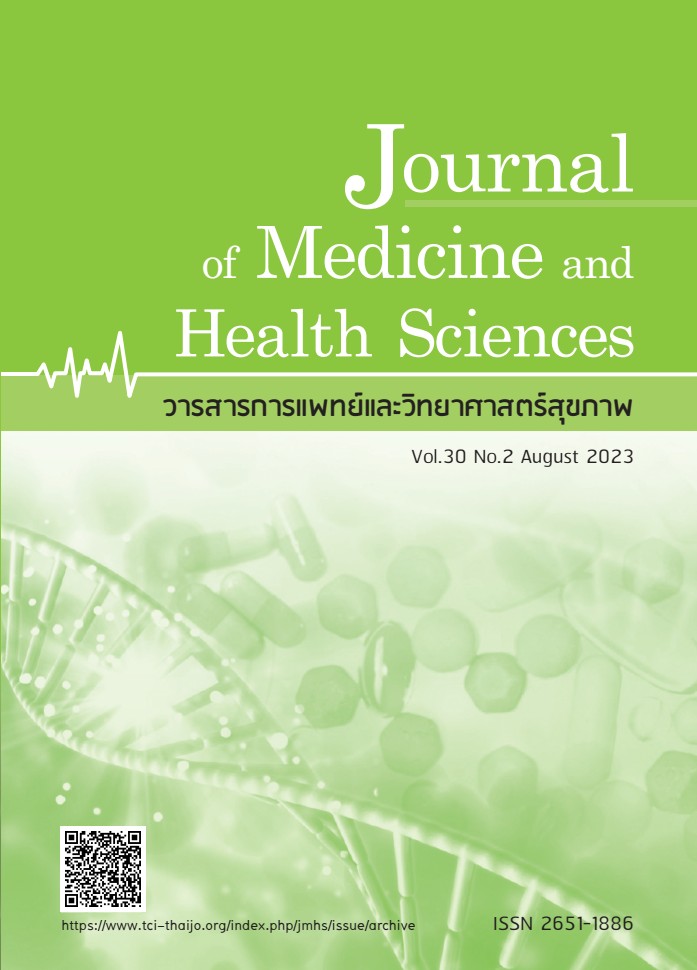ผลของการบริโภคนมต่อการเปลี่ยนแปลงของไขมันในเลือดในกลุ่มผู้ที่มีภาวะเมตาบอลิกซินโดรม
คำสำคัญ:
นมวัว, นมถั่วเหลืองผสมนมผง, นมถั่วเหลืองแคลเซียมสูงไม่เติมน้ำตาล, ไขมันในเลือดบทคัดย่อ
ภาวะเมตาบอลิกซินโดรมเป็นปัจจัยเสี่ยงต่อการเกิดโรคหัวใจและหลอดเลือด มีบางการศึกษาที่แสดงให้เห็นถึงประโยชน์ของการบริโภคผลิตภัณฑ์จากถั่วเหลืองว่าช่วยลดไขมันในเลือดได้ การศึกษาทางคลินิกนี้มีวัตถุประสงค์เพื่อศึกษาผลของการบริโภคนมที่ต่างชนิดกันต่อการเปลี่ยนแปลงของไขมันในเลือดในผู้ที่มีภาวะเมตาบอลิกซินโดรม กลุ่มตัวอย่างเป็นผู้ที่มีภาวะเมตาบอลิกซินโดรม จำนวน 70 คน ได้รับการสุ่มเป็น 4 กลุ่ม กลุ่ม 1 ได้รับนมวัว กลุ่ม 2 นมถั่วเหลืองผสมนมผง กลุ่ม 3 นมถั่วเหลืองแคลเซียมสูงไม่เติมน้ำตาลรสจืด และกลุ่ม 4 นมถั่วเหลืองแคลเซียมสูงไม่เติมน้ำตาลรสมัลติเกรน กลุ่ม 1 และ 2 บริโภคนมวันละ 500 มิลลิลิตร ส่วนกลุ่ม 3 และ 4 บริโภคนมวันละ 460 มิลลิลิตร โดยแบ่งบริโภคนมเป็นวันละ 2 ครั้ง ก่อนอาหารมื้อเช้าและมื้อเย็น 15-30 นาที เป็นเวลา 8 สัปดาห์ วัดผลการเปลี่ยนแปลงของไขมันในเลือดในสัปดาห์ที่ 0, 4 และ 8 วิเคราะห์ความแตกต่าง ภายในกลุ่มด้วย One way repeated measures ANOVA และ Friedman two-way analysis of variance วิเคราะห์ความแตกต่างระหว่างกลุ่มด้วย One way ANOVA และ Kruskal-Wallis test กำหนดนัยสำคัญทางสถิติที่น้อยกว่า 0.05 ผลการศึกษาภายในกลุ่มพบว่านมทั้ง 4 ชนิดช่วยเพิ่มเอชดีแอล-คอเลสเตอรอลได้อย่างมีนัยสำคัญทางสถิติตั้งแต่สัปดาห์ที่ 4 สำหรับนมถั่วเหลืองผสมนมผงและนมถั่วเหลืองแคลเซียมสูงไม่เติมน้ำตาล รสจืดสามารถลดแอลดีแอล-คอเลสเตอรอลได้อย่างมีนัยสำคัญทางสถิติในสัปดาห์ที่ 8 ขณะที่คอเลสเตอรอลรวมและไตรกลีเซอไรด์ไม่มีการเปลี่ยนแปลง ผลการเปลี่ยนแปลงระหว่างกลุ่มพบว่านมถั่วเหลืองแคลเซียมสูงไม่เติมน้ำตาลรสจืดลดแอลดีแอล-คอเลสเตอรอลได้มากกว่านมวัวและนมถั่วเหลืองแคลเซียมสูงไม่เติมน้ำตาลรสมัลติเกรน นอกจากนี้ นมถั่วเหลืองแคลเซียมสูงไม่เติมน้ำตาลรสจืดยังลดคอเลสเตอรอลรวมได้มากกว่านมชนิดอื่น ดังนั้นการบริโภคนมวัวและนมถั่วเหลืองทั้ง 3 ชนิด แสดงให้เห็นถึงการเปลี่ยนแปลงของไขมันในเลือดไปในทางที่ดี
References
International Diabetes Federation. The IDF worldwide definition of the metabolic syndrome Belgium: IDF Communications; 2006.
Aekplakorn W, Pakjaroen H, Thaikla K, et al. Thai National Health Examination Survey V. Nonthaburi: Health Systems Research Institute; 2016.
Rivas M, Garay RP, Escanero JF, et al. Soy milk lowers blood pressure in men and women with mild to moderate essential hypertension. J Nutr 2002;132(7):1900-2.
Tokede OA, Onabanjo TA, Yansane A, et al. Soya products and serum lipids: a meta-analysis of randomised controlled trials. Br J Nutr 2015;114(6):831-43.
Engel S, Elhauge M, Tholstrup T. Effect of whole milk compared with skimmed milk on fasting blood lipids in healthy adults: a 3-week randomized crossover study. Eur J Clin Nutr 2018;72(2):249-54.
Önning G, Åkesson B, Öste R, et al. Effects of consumption of oat milk, soya milk, or cow’s milk on plasma lipids and antioxidative capacity in healthy subjects. Ann Nutr Metab 1998;42(4):211-20.
Indrani D, Swetha P, Soumya C, et al. Effect of multigrains on rheological, microstructural and quality characteristics of north Indian parotta–An Indian flat bread. LWT-Food Sci Technol 2011;44(3):719-24.
Grundy SM, Hansen B, Smith Jr SC, et al. Clinical management of metabolic syndrome: report of the American Heart Association/National Heart, Lung, and Blood Institute/American Diabetes Association conference on scientific issues related to management. Circulation 2004;109(4):551-6.
Sakpal TV. Sample size estimation in clinical trial. Perspect Clin Res 2010;1(2):67-69.
Weidner C, Krempf M, Bard J-M, et al. Cholesterol lowering effect of a soy drink enriched with plant sterols in a French population with moderate hypercholesterolemia. Lipids Health Dis 2008;7(1):1-8.
Gardner CD, Messina M, Kiazand A, et al. Effect of two types of soy milk and dairy milk on plasma lipids in hypercholesterolemic adults: a randomized trial. J Am Coll Nutr 2007;26(6):669-77.
Bricarello LP, Kasinski N, Bertolami MC, et al. Comparison between the effects of soy milk and non-fat cow milk on lipid profile and lipid peroxidation in patients with primary hypercholesterolemia. Nutrition 2004;20(2):200-4.
Mensink RP, Zock PL, Kester AD, et al. Effects of dietary fatty acids and carbohydrates on the ratio of serum total to HDL cholesterol and on serum lipids and apolipoproteins: a meta-analysis of 60 controlled trials. Am J Clin Nutr 2003;77(5):1146-55.
Braaten J, Scott F, Wood P, et al. High β‐glucan oat bran and oat gum reduce postprandial blood glucose and insulin in subjects with and without type 2 diabetes. Diabet Med 1994;11(3):312-8.
Pick ME, Hawrysh ZJ, Gee MI, et al. Oat bran concentrate bread products improve long-term control of diabetes: a pilot study. J Am Diet Assoc 1996;96(12):1254-61.
Ravichanthiran K, Ma ZF, Zhang H, et al. Phytochemical profile of brown rice and its nutrigenomic implications. Antioxidants 2018;7(6):71.
Downloads
เผยแพร่แล้ว
How to Cite
ฉบับ
บท
License

This work is licensed under a Creative Commons Attribution-NonCommercial-NoDerivatives 4.0 International License.





